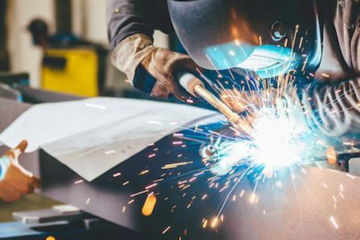Steel is among the most common and widely used metal alloys. It finds applications in numerous engineering and construction projects like the manufacturing of cars, buildings, ships, planes, surgical instruments, and household items like refrigerators, and washing machines, and in the manufacturing of structural steel.
Steel is an alloy of elements like iron, carbon, nickel, manganese, and chromium. The durability and strength of steel make it a versatile material. The two most common types of steel are stainless steel and carbon steel.
In this article, we will look into what makes stainless steel and carbon steel so different from each other and which materials are stronger and better so stay with us till the end.
Here is all you need to know about stainless steel and carbon steel
- What is Stainless Steel?
- What is Carbon Steel?
- Carbon Steel vs Stainless Steel
- Composition
- Tensile and Yield Strength
- Appearance
- Heat Resistance
- Corrosion Resistance
- Price Comparison
What is Stainless Steel?
Stainless steel is characterized by high corrosion resistance which is due to its high chromium content of greater than 10.5% and low carbon content which is less than 1.2%.
Unlike other iron-based alloys that undergo oxidation when exposed to atmospheric moisture and oxygen, the steel doesn’t undergo this reaction. The addition of chromium to this material creates a protective layer on the steel which keeps the environmental oxygen and the iron element of steel separated thus preventing rusting and corrosion.
This type of steel is used for automobiles, transportation, medical technology, cutlery and utensils, structural steel fabrication, water systems, and several household appliances like TVs, sinks, ovens, etc.
What is Carbon Steel?
This type of steel has a high carbon content of about 2.1% of its weight. According to the technical definition, true carbon steels must comprise iron and carbon only.
In carbon steel contents of copper, silicon, and manganese must not increase by 0.4%, 0.6%, and 1.65% respectively. There is no minimum content requirement for materials like chromium, cobalt, nickel, titanium, vanadium, and some other corrosion-resistant materials in this steel composition.
This type of steel finds applications in building frames for commercial and residential buildings, parts for bridges, pipes, and automobiles, and for making small products like nails, wires, and chains.
Steel with high carbon content is used in cutting tools, wrenches, springs, coils, hammers, and other construction tools.
Carbon Steel vs Stainless Steel
Now that you know what carbon and stainless steel are, let’s jump ahead and compare these two in terms of strength, composition, etc.
1. Composition:
Every type of steel has two main elements i.e., carbon and iron. It is the concentration of carbon and the addition of different elements that give steel its different properties.
In stainless steel, the ingredients like chromium, nickel, and molybdenum give it high corrosion resistance and strength. The content of chromium in this type of steel is more than 10.5%. This composition of stainless steel also makes it ideal for structural steel fabrication.
On the other hand, carbon steel contains iron and carbon as the main ingredients and very trace amounts of other materials. The amount of carbon in this type of steel can range from 0.05% to 3%.
2. Tensile and Yield Strength:
The yield strength refers to the ability of a steel to retain its form after the application of force. While the tensile strength measures the amount of force that is needed to crack the material permanently.
The low content of carbon in stainless steel makes it a little softer which results in low yield strength. This means it is easier to bend or dent stainless steel however, to break it you will need more force which means it has high tensile strength.
Carbon steel on the other hand has a higher yield strength. However, the value of tensile strength for this material is less than that of stainless steel. This means it will resist bending up to a certain point after that it will break down.
3. Appearance:
The finishes of both carbon and stainless steel are sleek and likeable. Carbon steel comes with a smoother and sleeker look which can be easily coated to increase performance as well as aesthetic appeal.
On the other hand, stainless steel has greater luster and shine which makes it stand out even from a distance.
4. Heat Resistance:
Stainless steel has a very high heat resistance. It can easily bear high temperatures due to having lower thermal conductivity. This type of steel can retain its properties even at temperatures as high as 1000 degrees Fahrenheit.
On the other hand, higher carbon can also bear high temperatures. However, having a higher thermal conductivity, it is not as good as stainless steel in terms of heat resistance.
5. Corrosion Resistance:
The high chromium content of the stainless steel reacts with the oxygen in the atmosphere which results in the creation of a chromium oxide layer over stainless steel. This layer creates a border between the oxygen present in the air and the iron present in stainless steel thus effectively preventing corrosion.
Carbon steel on the other hand lacks this protective layer due to low chromium content. This makes it more susceptible to rusting.
6. Price Comparison:
In general, stainless steel is more expensive than low or moderate-carbon steel. However, if your application demands the use of high-carbon steel, then you must know that it can cost you as much or sometimes even more than that of stainless steel.
When considering your option, it is better to assess the performance factor required for your application.
Conclusion
Both carbon steel and stainless steel are impressive in their way. Essentially both these materials are steel which gives them high flexibility and durability. However, by comparison, stainless steel has a slightly high tensile strength and yield strength which makes it less vulnerable to breaking.
On the other hand, carbon steel has a lower tensile strength but higher yield strength which means it can only maintain its shape to its breaking point after which it can crack permanently.
Different types of applications require different types of steel and it is up to you to figure out which way you need to go. By choosing the right type of steel for your applications, you can increase their efficiency and lifespan.
You can contact us at Power Solutions Industries to buy our top-quality structural steel for every application.


